Introduction
If you go to distrowatch.com and look down the rankings you will see at number 24 a distribution called SLAX.It is very hard for distro developers to make their particular distribution stand out. SLAX is not one of them.
SLAX weighs in at 210mb and is built to run from a USB drive as opposed to being installed to the hard drive. What you end up with is a fully functional portable operating system.
Installation
To download SLAX go to http://www.slax.org/en/download.php and click on the 32-bit or 64-bit zip file for your particular language.Now ordinarily when downloading Linux distributions you would download the ISO image and burn it to the USB drive using something like UNetbootin but to install SLAX all you need is a USB drive, the zip file and a program that can extract the zip file to the USB drive.
Once the USB drive has all the files extracted to it you just need to run the bootinst.bat file located in the /slax/boot folder.
You do not need to install SLAX to a hard drive because it is built to run from the USB drive.
First Impressions
The first boot is a little longer than subsequent boots but it isn't that long even on an Acer Aspire One D255 netbook.
As you can see you are greeted with a rather nice green KDE screen with a toolbar at the bottom.
In the bottom left there are three icons which from left to right when clicked, shows the menu, opens a terminal window and starts the Firefox web browser.
In the bottom right there are icons for keyboard layout, audio, display settings, network settings and a clock.
Next to the clock is a little hotspot that when clicked enables you to change the panel settings and add further widgets.
On the desktop itself there are two icons. The first one is a link to the SLAX software repository which I will explain further later and underneath that icon is a help guide which is definitely worth reading as it explains a lot.
In the top right corner is another hotspot which when clicked enables you to log out and change KDE settings.
Connecting to the internet
I had issues when I first tried to connect to the internet. The problem is that this netbook contains an Intel Centrino Wireless-n 1000 card and this driver isn't installed by default.Now I could tell you the way I got around it which was to:
- download the driver iwlwifi-1000-5.ucode
- copy the driver to /lib/firmware
- open terminal and type: modprobe -r iwlwifi && modprobe iwlwifi
Later on I'll show you an easier way of making sure you have the correct wireless drivers installed.
Flash and MP3
Rather surprisingly Flash worked out of the box and just as surprisingly I was also able to play MP3 files using the media player (Juk) without having to install extra drivers or libraries.
Applications
SLAX is obviously a lightweight distribution because it is built to run from a USB drive and the applications reflect this.Games
- KBounce - Ball bouncing game
- Bovo - 5 in a row
- KPatience - Patience
- KSudoku - Sudoku
- KMines - Minesweeper
Graphics
- GWenview - Image Viewer
- KSnapshot - Screenshot
- Kolourpaint - Paint
- Okular - Document Viewer
- KColorChooser - Colour selection
Internet
- FireFox - Web Browser
- Pidgin - Messenger
- KRDC - Remote Desktop
- KPPP - Internet Dialup
- KRFB - Desktop Sharing
- KNetAttach - Network Folder Wizard
Multimedia
- SMPlayer - Media Player
- JUK - Audio Player
- KMix - Sound Mixer
Installing Applications.
SLAX doesn't use tools like Synaptic or YUM to install software. Software is installed as modules and can be downloaded from the SLAX website.
To install an application you download it from the website and place it in the /lib/modules folder.
By placing the module in the /lib/modules folder it is available for use everytime you run SLAX.
You can activate and deactivate modules by clicking on the software center icon on the desktop.
The software center has three tabs.
The first tab has the "best picks" from the module library and as you might expect contains applications such as Google Chrome.
The second tab is called "All Modules" and when clicked just shows the following message: "Here will be interface to browse all modules. Soon. Stay tuned! :)".
The third tab is called "Active Modules" and shows all the modules you have installed thus far.
You can choose to active or deactivate modules by clicking the button to the right of each application.
Remember earlier on when I showed the method for installing the wireless drivers? Well instead of doing that I could have gone to the module downloads page and from the drivers section installed the firmware-iwlwifi module.
And finally...
So everything thus far has been fairly standard except for the fact that it all runs as a live USB rather than installing it to a hard drive.But I found something odd whilst looking for further information on SLAX.
Visit http://old.slax.org/build.php.
You can build your own version of SLAX by adding the modules you want to add and removing the modules you don't need.
When you are happy with your selections you can just download the ISO and install it to a USB drive. There are hundreds of modules available. (Many more than from the main SLAX website).
The main issue I have with this is that it seems to be an old version of the SLAX website. Is this now obsolete or is this still active? If this is still active then do the modules for SLAX on this website work with the version of SLAX from the main website?
I love the idea of being able to build your own ISO. It is like Linux Lego. There is no link from the main SLAX website to the link above. I found the above link by searching for SLAX on Google.
Summary
This review is just a cursory glance at what I have learned so far about this operating system. I plan to spend quite a bit of time investigating it further.The operating system works straight away from a USB drive and is easy to create. The modules system also makes it easy to install software.
For those who like to play, the USB base makes SLAX a good sandbox for compiling other modules that don't appear in the module repository. It is a great way to learn how to compile applications without messing up your main distribution.
The portability of SLAX means you can take it anywhere and interchangeable modules means you can get the drivers working without too much fuss.
The main issues I have are as follows:
- I don't see the point in having a tab in the software center that says "will be implemented shortly". Just hide the tab until it is available.
- Why is there an old site and a new site? I think this is confusing. Should you use the modules from the old site?
- A lot of the modules on the old site are shown as "Not verified" and it isn't recommended that you use modules until they are verified. Will this ever happen now being that this is an old site?
Thankyou for reading.


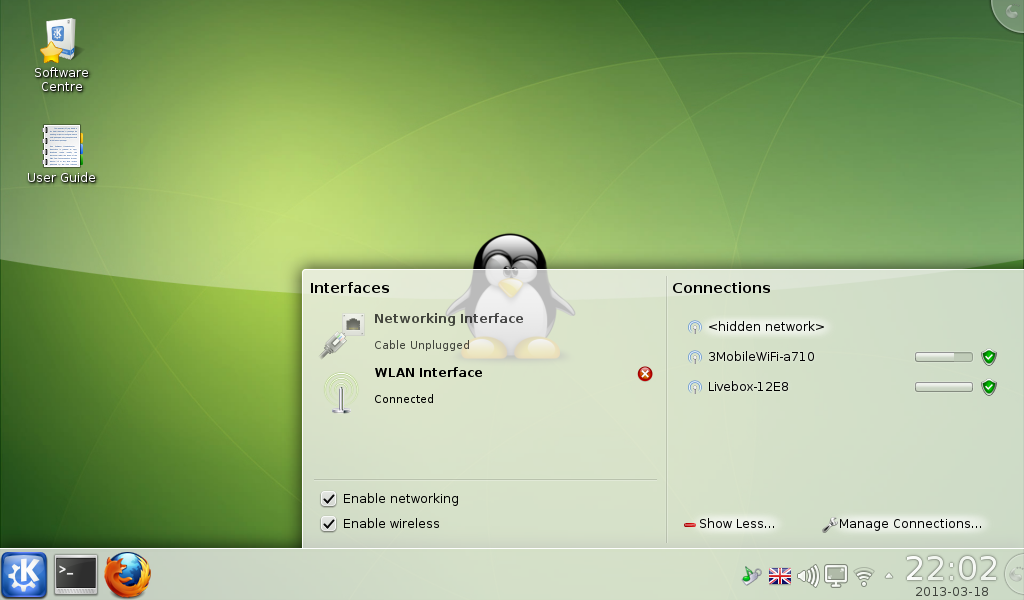
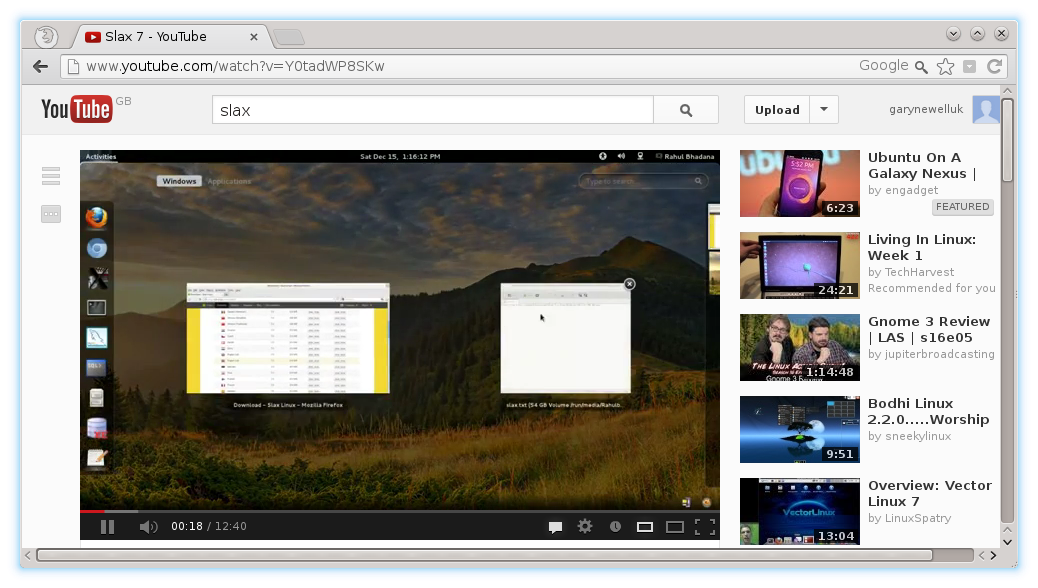
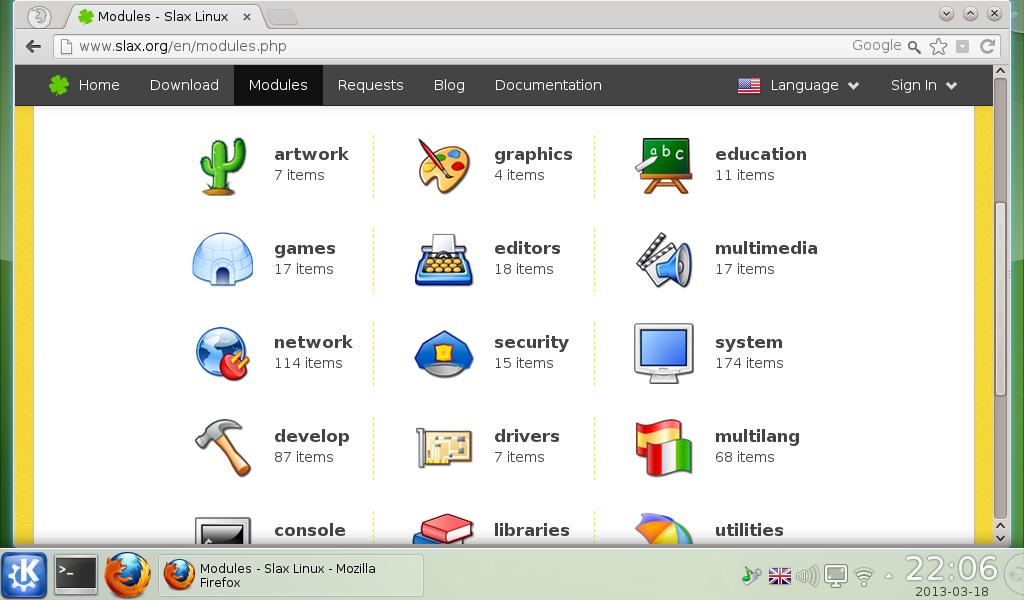
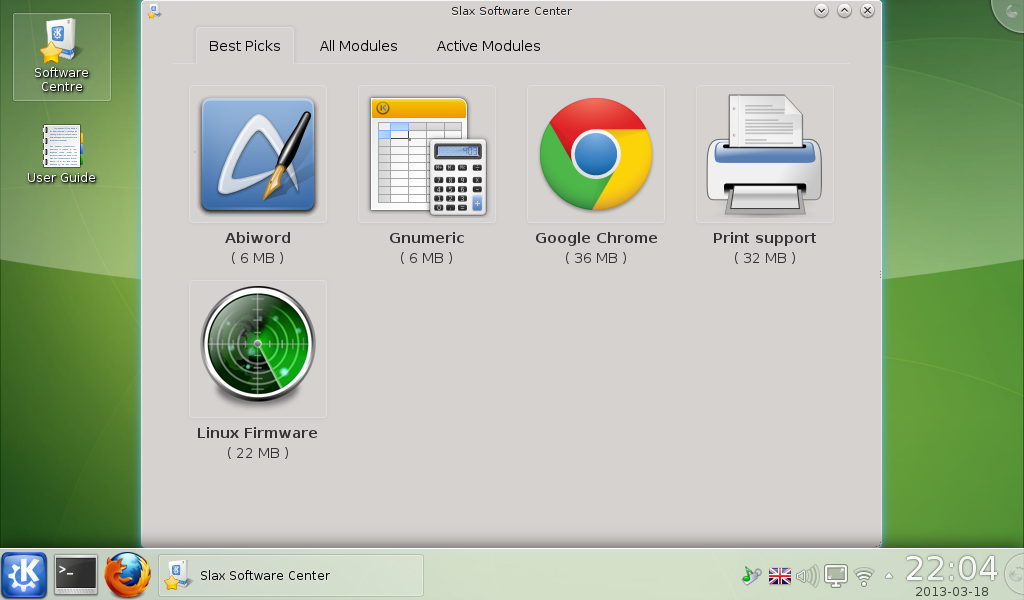
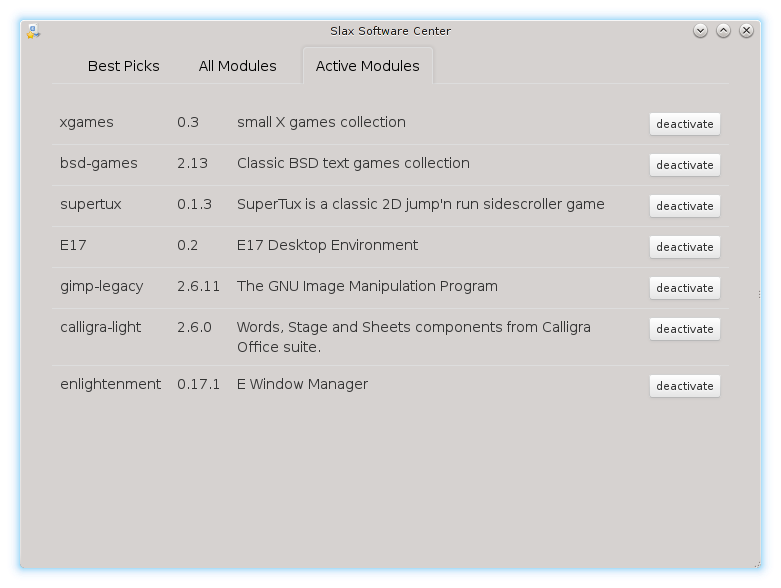

This is about the best Slax review I have seen in years.
ReplyDeleteThanks a zillion
Incidentally, and not a big deal, the driver (the kernel module that you loaded into your computer) for your wireless card was included, but the firmware (software that loads into the device itself) was not. The module won't load unless the device is working, which of course requires firmware loaded into it.
ReplyDeleteSome devices (most at one time) include firmware loaded on a ROM chip. That way you don't have to have the firmware available on disk, since the firmware will be the same regardless of what operating system the device is running under. Manufacturers have found it easier to keep firmware up to date, though, by making it so devices have to load it from the computer every time they start up. Otherwise, in order to update the firmware you have to use a program to flash the ROM chip on the device to update its firmware.
it would be good to get the console plugin back in kate activated by default
ReplyDeleteI made sb files.
ReplyDeleteBut,it's Japanese Url.
http://www11.ocn.ne.jp/~ksoft/slax.html
Hi. Thanks for your Slax analisys. Complete and concise. I use Slax on USB when I go out my office. Three years and no complaint.
ReplyDeleteI have a notebook Atom N270 1,6GHz and 1Gb RAM on XUbuntu 13.04. It works but almost stops when I have many Mozilla tabs open and LibreOffice Calc. I need tabs open and Calc working to do my job. Do you think Slax would be suitable as OS for this equipment? Thanks
Sorry for the mistake. I meant 'netbook' instead 'notebook'. Thanks
ReplyDeleteThis review convinced me to have a go to Slax. I think the issues you noted are far from being a serious hindrance to anyone wishing a stable distro in the pendrive.
ReplyDeleteHi I am new to linux
ReplyDeleteHave purchased usb stick and put some modules into module folder.
They show up as activated but I dont know how to run them.
For example could you tell me how to get ibreakout2 to run so I can play it.
If I find the file and click on it it says "open with"ow do I get it to run???
thanks
warren
H
I have Slax 7.0.8 on a bootable stick and am almost ready to go ... still stuck relying on Windows XP though, since I have not had the time to read up on making my Broadcom 802.11b/g WLAN work with this Slax version. A quick reply is appreciated, thank you. My Notebook is an HP Pavilion dv1000 - old, but trustworthy.
ReplyDeleteWhalewriter
I used to be a linux user around 10 years back, now trying slax, let's see how is the experience, if everything goes well, I will be completely switching to any popular distro..
ReplyDeleteHow hard would it be to get the old kpat look?
ReplyDeleteI don't much care for the new KPatience themes and color selection.